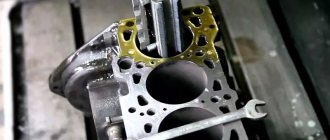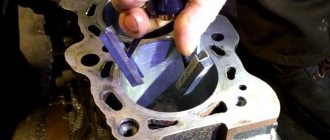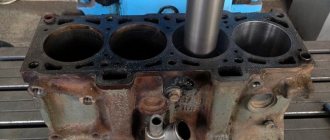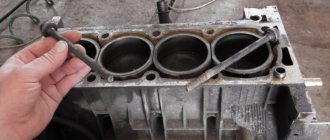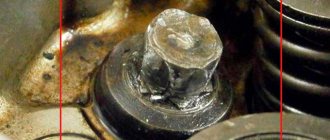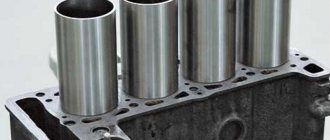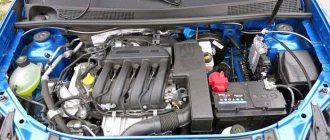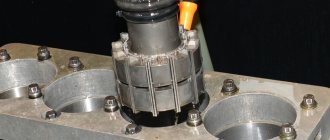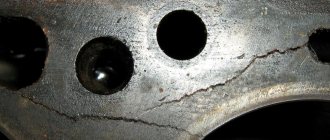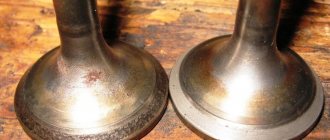What is the engine block made of?
The most common material used in production is cast iron. This is the traditional option. In second place is aluminum. Or rather, its various alloys. Well, there is also a rather exotic material - magnesium alloy. Now about all three options - in more detail.
Cast iron
This is a traditional material; this part has been made from it for many decades.
Cast iron was used with additives: nickel, chromium. Among the positive qualities of a cast iron product are: less sensitivity to overheating, rigidity, which is very important when boosting the engine.
The device mainly operates under frequent temperature changes, so cast iron products are a priority. The main disadvantage is the significant weight, which worsens the dynamics of a passenger car.
Aluminum
It has such positive properties as optimal engine cooling and low weight. It is in second place in terms of the number of cylinder blocks produced. A special feature of the aluminum design is the installation of sleeves.
Today, to perform this operation, two technologies are mainly used: Locasil and Nicasil. In the first case, sleeves made of an aluminum-silicon alloy are pressed in; in the second, a nickel coating is applied. The second technology has a significant drawback - if, for example, a piston burns out, a connecting rod breaks off, or the nickel coating fails, then the product cannot be repaired.
Also, nicosil technology does not provide for boring; the entire assembly has to be replaced. It is clear that in this case the car owner has to fork out a substantial amount.
Magnesium alloy
The engine cylinder block made from it is as hard as cast iron and light as aluminum. True, such a product is expensive, and for this reason it is not used in conveyor production, although it combines the best qualities of cast iron and aluminum. As you can see, each of the materials mentioned has certain pros and cons, but it would be incorrect to say that any of them is better.
Selection of aluminum casting alloy
The choice of aluminum casting alloy for the cylinder block requires consideration of various factors. Aluminum casting alloys, which are used in the production of complex castings such as cylinder blocks, must meet a combination of technical requirements. These requirements include:
- low cost;
- good casting properties;
- good machinability;
- sufficiently high strength at elevated temperatures.
Strength
The strength level of the alloy determines, for example, the minimum permissible wall thickness. Therefore, the choice of aluminum casting alloy should be made already at the first stage of designing the engine cylinder block. Usually the choice of aluminum alloy is a compromise. High-strength cast alloys might be the preferred choice, but they can often have disadvantages such as high cost, poor castability, and poor strength at elevated temperatures.
Restoring the cylinder block with oversize liners
If there is significant damage to the working surface of the liner, or it is necessary to restore the BC with liners of extreme repair size, the liners can be replaced. They are simply bored out until they are completely removed. New sleeves need to have an outer diameter of 0.05 - 0.07 mm. more seating space in the block and a persistent protrusion at the top. This tension and application of sealant at the top and bottom of the liner when installing it prevents coolant from leaking into the cylinder and pan. Also, the interference fit of the sleeve ensures good heat dissipation from its walls to the aluminum block. But when fitting a cast iron sleeve into an aluminum block with such an interference fit, pressing cannot be used. The fact is that the cast iron of the sleeve is harder than the aluminum of the block and when pressed it easily forms scuffs. In the area of the scuff, the liner wall does not adhere with its surface to the seat. Heat will not be dissipated in this area and local overheating may occur. In addition, when boring and honing the liner after it is pressed in, the wall of the liner in the place where it is not adjacent to the seat will “breathe”, impairing the accuracy of machining the working surface. The way out of this situation is to install “by hand” a liner cooled in liquid nitrogen into a heated cylinder block.
Advantages of aluminum cylinder blocks with dry liners
The advantages of aluminum cylinder blocks (cylinder blocks) with dry liners are the lower weight of the engine with such a block, its faster warming up and the smaller volume of antifreeze required for normal cooling compared to engines based on a cast iron cylinder block. However, the difference in the expansion coefficients of the aluminum piston and cast iron liner when heated while the engine is running, it doesn’t go away. Because of this difference, the gap between the cylinder and the piston cannot be reduced to less than 0.025 - 0.04 mm. Due to the constant change in the gap (when starting a cold engine, the gap is larger, and after heating to operating temperature, it decreases), the wear rate of the piston group did not meet modern requirements. As a result, increased oil waste, which prevents the engine from meeting modern environmental standards.
Making a piston from aluminum coated with iron
In order to reduce the gap between the cylinder and the piston as much as possible, they need to be made of metal with the same thermal expansion, i.e. made of aluminum. But aluminum cannot work on aluminum. Due to its low hardness, when an aluminum piston operates on an aluminum cylinder, scuffing occurs to the point of jamming. Mahle solved this problem by covering the aluminum piston with a thin layer (about 0.03 mm) of iron.
Such a piston works normally on an aluminum cylinder. Since the expansion of the aluminum piston and cylinder are the same, it became possible to make the gap between them no more than 0.02 mm. To increase the wear resistance of the cylinders, the silicon content in the BC aluminum alloy was increased to more than 18%. In the manufacture of such a block, after boring the cylinders, chemical etching of their walls is used to expose silicon crystals on their surface. The manufacturer called this coating Silumal.
Boring and honing of Silumal aluminum blocks
Repair of such cylinder blocks is carried out in the same way as cast iron ones, by boring to the repair size and subsequent honing. However, honing aluminum blocks is very different from cast iron ones. Processing is usually done in three steps. In this case, bars with different abrasive sizes are used. From the largest to the smallest. The abrasive particles of such whetstones contain silicon carbide, because When honing, you need to cut not only soft aluminum, but also very hard silicon. Also, the coating composition of the hone head bars does not allow aluminum shavings to stick to them, which can cause serious scuffing on the cylinder wall. After honing, another operation is needed to expose the silicon crystals. Instead of chemical etching, polishing with a special silicone paste containing a small amount of silicon is used during repairs. In this case, a thin layer of aluminum (0.001 mm) is removed, and the silicon crystals on the cylinder walls are not affected. You can find out all the most interesting and relevant things on our website quality21.
Iron-based plasma spray layers
This method has been used in the series for several years. During plasma coating, an electric arc is excited in the plasma torch. The supplied plasma gas (hydrogen or argon) is ionized to a plasma state and leaves the torch nozzle at high speed. Using a carrier gas, the coating material (e.g., composed of 50% alloy steel and 50% molybdenum) in powder form is applied in a plasma beam at a temperature of 15,000-20,000 ° C. The coating material is melted and injected in a liquid state at a speed of 80 to 100 m/ from onto the surface to be coated. If necessary, ceramic materials can be additionally integrated into the plasma sprayed iron layer. The process occurs at atmospheric pressure. Image 3 shows a schematic of the coating process.
The layer thickness obtained with plasma coating is 0.18-0.22 mm. The coating is finally processed by honing. The layer thickness remaining after honing is approximately 0.11-0.13 mm.
Image 4 shows a magnified microscopic view of a cross-section of the working surface of a plasma-coated cylinder. Image 5 shows an enlarged view of the finished machined cylinder running surface. The depressions in the working surface, resulting from the porous plasma layer, are clearly recognizable. Motor oil can be deposited in the recesses, which improves the friction and wear properties of the working surface.
Thanks to plasma coating, engine life is increased, and due to lower fuel and oil consumption, harmful emissions are reduced. Thanks to the small thickness of the plasma coating layer, it is possible to achieve even smaller distances between the cylinders in relation to cast-in cylinder liners made of gray cast iron, which has a positive effect on the structural length of the engine.
| Image 3 |
| 1. Water cooling 2. Supply of flammable gas 3. Outlet nozzle 4. Powder supply 5. Plasma Beam 6. Plasma coating |
What is the price?
The price of a cylinder block liner may vary significantly. Typically, this cost includes work on boring and honing of cylinders. So, for VAZ cars, the entire set of work costs 5 thousand 300 rubles, excluding the bushings themselves.
UAZ internal combustion engine sleeve - 6 thousand 500 rubles. For GAZelles with ZMZ engines, this service costs 4 thousand 300 rubles. For Cummins engines - 2 thousand cheaper. As for foreign cars, the cost of lining a cast iron block (without boring and honing) is 2 thousand 300 rubles per cylinder. The same work, but with an aluminum block for 200 rubles more.
Where is the cylinder block liner made? St. Petersburg and Moscow are not the only cities in which this service is offered. You can find a good sleeving specialist in much smaller settlements.
Electric motor scrap price
Prices for scrapping electric motors are approximately 20 rubles/kg - the average market price in Russia. This means that unassembled electric motors can be brought to a collection point - they are hung and charged at 20 rubles/kg, which, in principle, is also not bad, because some even manage to sell electric motors as scrap ferrous metals, under category 3A.
The price for scrap electric motors may depend on: the number of motors, the amount of work that needs to be done to crush the electric motor housing and perform the separation of non-ferrous and ferrous metals.
If there are many engines, then it is more cost-effective to separate copper and cast iron (electric motor housing). To do this, you can hire a person who will chop the hulls with a sledgehammer, and another will extract copper. It all depends on the number of engines. If there are a lot of them, then the work may take several days, while wage costs will be scanty - 1500-2000 rubles per day, and the income received from copper and cast iron will ultimately more than cover all costs.
Electric motor scrap, the price of which is determined by the weight and power of the engine, as well as its design, is an important source of supply of raw materials of ferrous and non-ferrous metals to metallurgical mini-plants.
Source
Varieties
There are several types of sleeves:
- Dry.
- Wet.
The first is installed in the engine block, which has no contact with the coolant. Wet liners on one side come into contact with antifreeze. Such elements are equipped with special gaskets that prevent liquid leakage from the cooling system and its penetration into the cylinder. This seal also prevents exhaust gases from breaking through into the ODS.
Basic requirements for sleeves:
- Resistant to temperature changes.
- Corrosion protection.
When selecting these elements, pay attention to the thickness of the cylinder walls, their ellipse and taper. Tolerances for boring the liner after it is installed in the engine are taken into account.
Cylinder block design
The engine cylinder block must satisfy the following requirements: ensuring the alignment of all beds, as well as maintaining an equal diameter of the beds. There are also units in which these requirements are not met, but these are only special and experimental designs.
As we noted earlier, the cylinder block is the basis for other units. Its main details are as follows:
- Engine cylinder. The larger they are, the more powerful the motor. The volume is summed up and the final figure is announced in the vehicle characteristics. The main part of the cylinders are liners, which come in two types. The first type is used only in aluminum blocks - these are liners pressed directly into the cylinder block. The second type is removable sleeves. They are “dry” and “wet”.
- Block head. Consists of mounting points for the timing belt, combustion chamber, spark plug holes, intake and exhaust ports, as well as a cooling jacket and lubrication channels. The head is attached to the top of the cylinder block itself. But if other units in the car are simply attached “by eye”, that is, until the bolt cannot be turned, then here the bolts are tightened using a torque wrench. Each car has its own parameters and tightening patterns that must not be violated.
- Carter. In all internal combustion engines, the crankcases can be called a part of the block, and not an attached unit. It is a housing for the crank mechanism. The crankcase is secured to the bottom of the cylinder block and covered with a special pan for protection.
No matter how reliable internal combustion engines are, sooner or later their service life comes to an end. This is especially true for the internal combustion engines of old VAZ cars. Lining the cylinder block is one of the frequent operations that is performed during engine overhaul. What is the essence of this technology, what does it provide and how is it done? Read about all this further in our article.
Non-ferrous metal in the engine. Is it possible to submit?
All non-ferrous metal contained in the engine can be returned at a profit if you contact a specialized collection point. Not every acceptance facility has a manipulator available, so not all organizations are able to load, transport and weigh an internal combustion engine, which can weigh up to 200 kilograms. The non-ferrous metal will not accept the entire engine, but only some of its components, which are made of non-ferrous alloys. Usually, entire engines are accepted as ferrous scrap metal, so it is better to disassemble the unit in advance and separate the parts from non-ferrous scrap. In Moscow and the Moscow region, you can hand over an old car engine at a good price. For example, VtorBaza buys scrap motor aluminum (at a price of 90-118 rubles/kg), and you can also hand over cast iron from the cylinder block of your car’s internal combustion engine. This reception point has all the necessary special equipment, loaders and trucks. helps with organizing transportation, weighing, disassembling and evaluating the engine, with its subsequent purchase. At the same time, the price for all ferrous and non-ferrous metals accepted at acceptance is higher than in other points in the region.
Alternative technology
The above method involves preliminary boring of the block. But there are blocks (this applies to aluminum ones) that are not bored before installing the sleeves. What do you do in this case? The cylinder block liner is accompanied by the application of sealant to the seat.
Next, the sleeve is pressed into place on a special machine. The temperature of the sleeve and block are the same. A high-quality liner allows you to operate the internal combustion engine for 150 thousand kilometers, subject to timely oil changes.
Cast iron engine block
This procedure is especially important for engines of heavy trucks and construction equipment.
The covers of the main bearings and their seats are thoroughly cleaned of dirt, after which the covers are installed in their places, and the fastening bolts are tightened to the prescribed torque using a torque wrench. The indicator bore gauge is adjusted to the required size (nominal diameter of the crankshaft bed). We measure each support in several planes. The differences between the obtained dimensions and the nominal ones should not be more than 0.02 mm. Otherwise, it is necessary to perform an operation to repair the crankshaft bed.
The mounting holes for various bushings are checked in the same way. They can be repaired by installing new bushings with an increased outer diameter.
If, according to all the above parameters, the unit is suitable for further operation, it is necessary to carry out repair work. After repair, the cylinder block must be thoroughly washed and blown with compressed air to remove contaminants.
Related pages:
- ... located on both sides of the cylinder blocks. The cover of the timing gears is attached to the front part of the cylinder block ... rotation of the cylinder block electromechanical Rotation frequency of the cylinder block, rpm 4.07 Rotation angles of the cylinder block, degrees ...
- ... for this purpose, channels for lubrication and cooling are made in the cylinder block. Beds are made in the cylinder block ... production technology of internal combustion engine cylinder blocks. In which I described the cylinder block itself and analyzed the conditions...
- Repair of cylinder blocks The material of the cylinder block is gray cast iron. Possible defects in cylinder blocks: holes and cracks on the wall... of liners. Repair of base surfaces of cylinder blocks. Significant distortions of the geometric shape occur in the cylinder blocks...
- ... cylinder blocks for the engine. 6 Checking the technical condition and repair of the cylinder head. Wash the cylinder head thoroughly...
- ... cavities. Stand for testing cylinder blocks for leaks 5 Drilling ... Rinse and blow out the cylinder blocks Installation for washing cylinder blocks OM-3600 compressor. ... Transition content 1 2 3 4 5 6 Install the cylinder block at an angle of 45° on the device ...
I want more similar works...
How is cylinder head porting carried out?
Before porting the cylinder head, you need to check that you have several components:
- Inlet/outlet type channels;
- Guide bushings;
- Valves;
- Springs/plates for bushings;
- Combustion chambers.
Next we follow the instructions:
- Take the cylinder head and remove all the valves present on it.
- Inspect the channels, remember the places where defects are present.
- Remove the guides.
- Use the helper pins to install the intake manifold.
- Using bolts, screw the auxiliary studs into the separate channels intended for the cooling mixture. Small holes can be made in the studs to maintain normal heating.
- We combine the manifold with the cylinder head.
- File down the intake manifold.
- When work on the collector comes to completion, you will have to combine the channels. Docking can be done using plasticine.
- Use a chisel to remove any rough spots on the exhaust type valves.
- Subject the remaining channels to a thorough polish to remove all surface defects.
The result of all the above-described manipulations will be that the cylinder head will have more advanced characteristics:
- The diameter of the intake channels is 32 millimeters;
- The diameter of the exhaust channels is 29 millimeters;
- The diameter of the valve stems is 8 millimeters;
- Camshafts cylinder head, sports - standard - 13.5 millimeters;
- The guide type bushings are longer than standard.
Thus, by modifying the cylinder head, it is possible to maximize the potential of a car engine.
Engine for scrap
Many people have an old car. It can either be inherited, or simply be an item of long-standing luxury. As a rule, the engine of such a car is in a rather reverent state. To bring it into working condition you will have to spend a tidy sum and put in a lot of effort. In most cases this is quite impractical. In this case, it is better to sell the entire car for scrap. If you changed the engine - bought a new one or installed a contract one with mileage, then the question arises - where to put the old non-working car engine?
One thing that comes to mind is to sell the engine for scrap. This is truly the best choice because there is nowhere else to put it. Here you can not only get rid of old “junk”, but also receive financial rewards.
And if you think about it globally, it turns out that you are giving the metal a new life! Having gone through a full processing cycle, it will either turn into a machine tool, or into some kind of part, or they will simply cast a clean sheet of metal from it.
Possible faults
During operation, the master brake cylinder, like all vehicle mechanisms, becomes unusable, which entails repair or replacement of parts. The main reason may be uneven distribution of brake fluid inside the structure. Diagnosis of malfunctions is carried out first using an external inspection: checking for defects and brake fluid leaks. Then they check the functionality of the unit: with normal pressure on the rod, there should be no jamming or sagging.
The brake wheel cylinder, as a rule, wears out over long periods of use and is also affected by rust on the inside. This is a consequence of foreign substances (water, oxygen) entering the brake fluid. There are also such nuances as: wear of the sealing collar and return springs, their lifting, and also the dilapidation of the device mirror. Such violations require mandatory repair or replacement.
Other factors that cause a wheel brake cylinder to break include its depressurization. This is revealed by external inspection: a characteristic trace remains and a strong odor is present, the liquid level will quickly decrease. A wheel brake cylinder in which the sealing covers on the outside are swollen indicates that the internal seals are also unusable.
Cylinder block materials
Since ancient times, the cylinder block has been made of cast iron. This is a fairly durable and rigid material that is not subject to overheating. These qualities were what automakers needed, because the engine can reach quite high temperatures during operation. Cast iron was usually used with admixtures of nickel and chromium. The last two materials give greater durability to the structure. Of course, the main disadvantage of cast iron is its mass; cars lost maneuverability and speed.
Therefore, cylinder blocks began to be made of aluminum. This metal is much lighter than cast iron and also has lower thermal conductivity. Naturally, aluminum is not an ideal solution, because the main problem is the selection of material for the block.
There is a third option - magnesium alloy. Of course, magnesium is much lighter than aluminum and cast iron, and also has the rigidity and hardness of the latter. However, installation of such a unit is more expensive and therefore not suitable for widespread use. Magnesium blocks are installed when tuning the engine in order to ensure maximum acceleration and maneuverability. These designs are mainly used on racing cars.
Aluminum blocks are currently produced using two technologies: Locasil and Nicasil. The first involves pressing sleeves made of an alloy of silicon and aluminum, and the second involves coating the aluminum surface of the block with nickel. Of course, the latest technology has a big drawback, because if a connecting rod breaks or one of the pistons burns out, the nickel coating no longer functions properly, and the cylinder block itself cannot be repaired. In this case, the winner is a cast iron engine, which can be bored and lined using a rebuild kit.
Difficulties in disassembling an electric motor for scrap and solving the problem
We invite you to read the real story of our subscriber about his experience in extracting copper from scrap electric motors - Copper and the AIRHM132S6U3 electric motor .
Electric motors that are subject to scrapping differ in power, size and type, and, therefore, have different designs.
For example, based on their size, motors can be divided into small, with a power of up to 3 kW, medium, with a power of up to 10 kW, and larger. The design of AC and DC motors also differs.
Many Vtorchermet bases offer their services for engine dismantling. However, with proper qualifications, such work can be done independently. Moreover, it is possible to simultaneously sort parts made from different metals and alloys. There are several cutting methods before scrapping an electric motor. The simplest is considered to be opening the housing, separating the stator from the rotor, and then subsequently sorting the parts. For this purpose, mechanized separation can also be used, but in such situations it is ineffective, so many works are performed manually. In addition, it is impossible to remove aluminum and/or copper windings, and the majority of non-ferrous metals and special steels do not change their type at all. For example, electrical steel plates remain in the insulation layer, and the shaft is often not removed.
How to check the oil in an automatic transmission?
We recommend reading: How to check the oil level in an automatic transmission
The easiest way to check the oil in an automatic transmission is to take a sample. It is almost impossible to determine “by sound” or by the nature of the car’s movement that the oil in the box needs to be changed, unless we are talking about critical cases.
To check the oil in the automatic transmission, you should take a little sample and drop it on a white sheet of paper or rags. Next, it remains to determine the degree of oil contamination by color, in accordance with the following rules:
- The oil is transparent. If the oil is clear, then it does not need to be replaced. In this case, you should not pay attention to the color of the oil. During operation, pink oil may turn black, but the main thing is that it remains transparent;
- The oil is cloudy. If no white sheet is visible through the oil, it is contaminated with small particles and should be changed. In this situation, the driver can choose a complete or partial oil change;
- Oil interspersed with shavings. If metal shavings or other particles are clearly visible in the oil sample taken from the box, it means that there will soon be big problems with the transmission. This oil also has a pungent burning smell. Most often, when metal shavings appear, changing the oil will no longer be able to save the automatic transmission from destruction.
If you suspect that the gearbox is beginning to deteriorate, you can completely drain the oil and remove the pan to diagnose a problem with the gearbox. A clean pallet will show that the fears were false. If small metal shavings (so-called “hedgehogs”) have stuck to it, you should understand that the destruction of the automatic transmission has begun, and soon the transmission will stop working properly. Having noticed obvious pieces of metal on the pallet, which can be more than 1 mm in diameter, you can diagnose the actual destruction of the gearbox and the need for urgent major repairs.
What's the result?
Studying the issue of the applicability of materials in engine building shows a clear direction: to reduce weight and improve other characteristics, the use of some supermaterials is either not particularly required or is impossible in principle due to physical and chemical properties. The development of technology follows an evolutionary path - improvement of both production itself and traditional materials, reorganization of the work process and design optimization. So, even in the medium term, we are unlikely to see a revolution in the production of internal combustion engines; rather, we will be talking about a gradual abandonment of this type of engine in principle in favor of electrical technologies, although there has not yet been a rapid technological breakthrough there.
Source
Chemical composition and heat treatment
Cast aluminum alloys used for automobile engine blocks typically include alloys 46200 and 45000 according to European Standard EN 1706 (the cumbersome “EN AC-“ prefix is omitted). The chemical “formulas” of these alloys are respectively AlSi8Cu3 and AlSi6Cu4. Their American analogues - better known - are the alloys A380.2 and A319. These hypoeutectic aluminum-silicon alloys are typically produced from recycled aluminum. Automotive cylinder blocks are cast from them using various gravity casting methods.
Table - Chemical composition and conditions of aluminum casting alloys for cylinder blocks
The relatively high copper content allows these alloys to maintain their strength at elevated temperatures and, in addition, provides them with good machinability. Usually for these alloys - 46200 and 45000 (A380.2 and A319) - states F (cast state), T4 (hardening and natural aging) and T5 (incomplete hardening and artificial aging) are used. For castings from these alloys, the T6 condition can also be used, but for many products made from these alloys, the T5 stabilizing condition is sufficient.
Almost all cylinder blocks that are cast by high pressure casting are made from alloy 46000 (AlSi9Cu3(Fe)). Typically, this alloy does not require heat treatment other than moderate tempering to reduce residual stresses.
Cylinder blocks made of aluminum alloys 42100 (AlSi7Mg0.3) and 42000 (AlSi7Mg) obtain high strength and elongation at room temperature when heat treated to T6 condition. In this case, it is necessary to carefully monitor the residual stresses that arise during hardening of the casting to achieve the T6 condition. The higher crack resistance of these alloys gives them the ability to withstand thermal fatigue loads. This occurs at the expense of a certain deterioration in machinability and an increase in cost due to the additional costs of heat treatment for the T6 or T7 conditions. Meeting the requirement for lower levels of impurities such as iron, manganese, copper and nickel also requires additional costs compared to the secondary alloys mentioned above.
Cylinder blocks made of hypereutectoid aluminum-silicon alloys (AlSi17CuMg) are usually cast by low pressure casting followed by heat treatment to T6 condition. This alloy is also more expensive than standard recycled aluminum casting alloys.
Laser alloying of cylinder working surfaces
Image 1
1. Laser beam
2. Powder jet
3. Rotating laser optical device
4. Alloy layer
5. Melted zone
Laser alloying is a further method of reinforcing the working surfaces of cylinders with silicon. With laser alloying, the working surface of a cylinder block made of a standard aluminum-silicon alloy (for example, AISi9Cu3) is melted using a rotating laser optical device and metallurgically alloyed by parallel supply of powder (silicon, etc.) (Fig. 1). This results in a thin layer with a very finely separated solid phase (mainly silicon) in the area of the inner surface of the cylinder. The cylinder bores must still be honed after laser alloying and the silicon particles must be exposed. Since the particle sizes are small (within a few centimeters), the opening of integrated silicon crystals is expediently carried out by chemical etching. The process of opening by chemical etching is described in more detail in the chapter “3.6.2. Various methods of opening silicon.”
